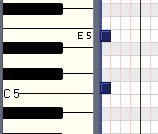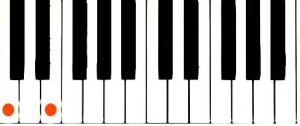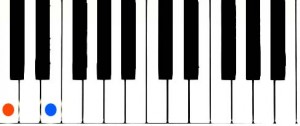In the previous article we looked at the Major 2nd.
In the following article we’re going to concentrate on the Major 2nd and touch on the Minor 2nd.
As with the previous article screen shots will be used to explain how to play each interval and then at the end I’ll talk about uses of each interval.
If you’ve landed on this page without reading my previous articles it would be a good idea to read those articles first.
Theory: Working with Intervals (part 1)
Working with Intervals (part 2) Major 2nd
——————————————————————————————————-
As before the following is in the Key of C
:::Major 3rd:::
Piano Roll:
Staff View:
Piano:
Guitar TAB:
The above examples show the
Major 2nd Interval being played together.
Try plying the notes seperately, First C then E
Piano Roll:
Staff View:
Piano:
Piano: Play the ‘red dotted’ key first(C) then the ‘blue dotted’ key(E)
Guitar TAB: First note is C Second note is E
Playing the above interval in sequence or together is good practice, as with the Major 2nd play it repeatedly in both variations.
Why not play the Major 2nd with the Major 3rd following, try it in both variants.
The Major 3rd interval is important in your Major Chord spelling.
It’s the integral part of the chord, it gives the chord it’s moniker.
C – E = a Major 3rd – the chord of C Major is C – E – G
If the Major 3rd is altered, ie the 3rd, the E is flattened by a semitine we get a Minor 3rd interval.
C – Eb = a Minor 3rd – the chord of C Minor is C – Eb – G
——————————————————————————————————-
When playing or writing a melody the usage of the Major 3rd or Minor 3rd interval has an immediate impact.
Experimenting and listening is the best way to get to grips with this imformation.
When creating harmony you can of course use Major or Minor 3rds dependent on key.
That is unless you are using purely ‘powerchords’ or ‘5th chords’ – more about 5ths in a future article.
To use the the 3rd notes as harmony, record one guitar/piano playing the C.
Now while that track is being played back try playing your 3rd over the top, try the major 3rd first, then try the minor 3rd.
The effect you’ll get will sound different than playing the two notes at the same time on one instrument.
Stacking 3rds is an interesting concept,
Going back to the C Major Chord,
C – E = a Major 3rd – the chord of C Major is C – E – G
In the chord spelling article I wrote a chords spelling is Root/3rd/5th.
That is the second two notes the 3rd and the 5th are intervals of C
C – E = Major 3rd and E – G = Perfect 5th.
To look at it another way using 3rds,
C – E = Major 3rd and E – G = a Minor 3rd
Let’s take this further by adding another 3rd interval,
If we add a major 3rd to G we get B
This gives us a chord spelling of,
C – E – G – B
C – E = Major 3rd – E – G = a Minor 3rd – G – B = Major 3rd
This gives us the chord of C Major 7.
You can go further and have chords of 5 notes, 9th chords or 6 notes 11th chords and 7 notes gives us 13th chords.
So ok figuring out these chords on guitar is a pain but it does open up your thinking a great deal both melodically and harmonically.
This kind of thinking though is not directly linked to your ‘main’ instrument.
When you’re arranging you’ve now got a lot of options.
Imagine you have a peice with piano, guitar and bass.
Using the ranges each instrument occupies and notes rather than chords to create ‘stacked’ chords we can get interesting sounds and open up your music in unique ways.
Take the chord progression C/ Am/ G/ Dm
As a simple piano or guitar chord progression it could sound quite uninspired.
But if you take the Root note and have your bass play those.
Your piano plays the 3rd and the guitar plays the 5th.
Bass: C A G D
Piano: E C B F
Guitar: G E D A
You could invert each chord, Which would mean playing a note an octave lower,
In the following example the Bass note is now playing the 3rd,
The Piano is now playing the 5th,
And the Guitar is playing the Root but an octave higher.
This is ineffect an inverted chord,
Bass: E C B F
Piano: G E D A
Guitar: C A G D
We’re done for the time being. Try experimenting with the ideas and theory presented above.
In the next article I’ll be covering 4ths and 5ths.
Have fun.
——————————————————————————————————-
Related Articles:
Theory: Working with Intervals (part 1)
Working with Intervals (part 2) Major 2nd







